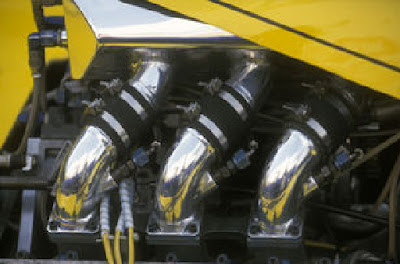It's official since June 30. The formula 1 goes from 2014 with six-cylinder turbo engines. The FIA has identified the technical cornerstones for the V6 turbo with the engineers of the manufacturer. Everything else remains as at the originally planned engine.
F1 Gets a new engine. And she gets a green face. Efficiency is more important than power. Only a detail has been changed. A V6 turbo was a four cylinder in-line engine with charge.
In December 2010, the four manufacturers represented in formula 1, Ferrari, Mercedes, Renault and Cosworth had still supported the four idea of FIA for 2013. But soon the first doubts came up. Ferrari is worried about the image. Cylinder and F1, which pass not together,'s President Luca di Montezemolo. Cosworth was expecting to and found out that the new development of a four-series engine was not financially viable. In the middle in the conflict, Bernie Ecclestone played its own game. He feared that a four-cylinder engine of no formula would develop 1-just noise and wanted to keep the V8. Some engine manufacturers were on time and asked to delay until 2013. Which refused the FIA. Fearing it would lose sight of the goal.
The result is a compromise. The team and manufacturer, pleaded for a V6 with all the ingredients that were already been adopted by the FIA in December: 1.6 L engine, Mono Turbo, direct injection, limited fuel flow rate, hybrid technology, an increase in the lifetime of 2,500 to 4,000 kilometres per unit. Four advocates Renault was hesitant to Board level. Cosworth sees better opportunities to pay the v6 development because the motor specialist from Northampton to build just a 2.2 L V6-turbo for the IndyCar Series. As one would have a base ever. And the initial date of 2014 gives them more time.
That when the concept studies for the four already money has been wasted, so that engine manufacturers have to live now. Finally, it was their idea to replace the R4 against a v6. After several meetings and votes within the technical working group and the formula 1 Commission of the FIA World Council blessed from the V6 turbo as the basis of new regulations on June 30.
The World Association can live with a v6. Because at the end of that same comes out like in the engine. The plan to reduce fuel consumption by 30 percent remains. Also, if you now have two cylinders, 15,000 rpm instead of 12,000 rpm turns, drops the drilling of 88 at still relatively large 80 mm and changes otherwise the entire architecture of the engine. Efficiency is guaranteed by the fact that the FIA is insisting on a controlled fuel flow rate. Roughly: it 100 kg fuel per hour may be used up.
At first glance, this seems incompatible with the Rev limit increased to 3,000 rpm. The engineers have provided as even a great job. You have to work now even harder to reduce internal friction and moving mass to achieve the consumption Cap. The internal combustion engine is too thirsty KERS comes ERS, pardon, into play. The power of Hybridantriebes must be used then to compensate for excessive consumption.
Who is building an economical engine, can siphon extra power from the energy recovery system. The "K" of KERS is not needed, since not only kinetic energy may be rekuperiert but also the energy of the exhaust gases cannot be cast. The allowed storage energy amounts to 4,000 instead of 400 kJoule, so the amount of ten times. You can so easily calculate themselves how often the driver of a car with an efficient engine can press the ERS button, which then activates 163 HP at the rear wheels. Almost the entire round long.
The speed increase proposed by the motor engineers at 15,000 rpm has two reasons. Firstly, it aims to ensure a good sound. He is still supported by the relatively large turbine of the turbocharger. Secondly is it between 12,000 rpm and 15,000 rpm to give a similar flat torque curve as before when the planned four between 8,500 rpm and 12,000/min. The chassis designers want an eight-speed transmission with a previously fixed translation for cost reasons. You will then give in Monte Carlo on the course of 7 and 8 and at Monza on the corridors 1 and 2.
The FIA experts believe that the engine engineers need to invest much brainpower, to achieve the defined objectives. Perhaps more than in the engine. Not only to meet the consumption formula. A solution with a turbocharger is a challenge with a V6, because first of all the six exhausts must be transformed into one. The turbocharger sits then logically far back and high, and this requires relatively long exhaust pipes. With a Turbo, you would have had it easier.
Also the question of the cylinder angle is not as easy to clarify. It is the only detail that still open. The producers want to communicate with the FIA to GP England to a common denominator. Was originally at 90 degrees. However, 120 degrees are the logical angle for a v6. At a such a large angle it could be but structural problems, and at the end, it would up too much space, you cannot do anything in the V. The chassis designers want to avoid a subframe but in any case. This was also one of the strongest arguments against the series four-cylinder engine.
